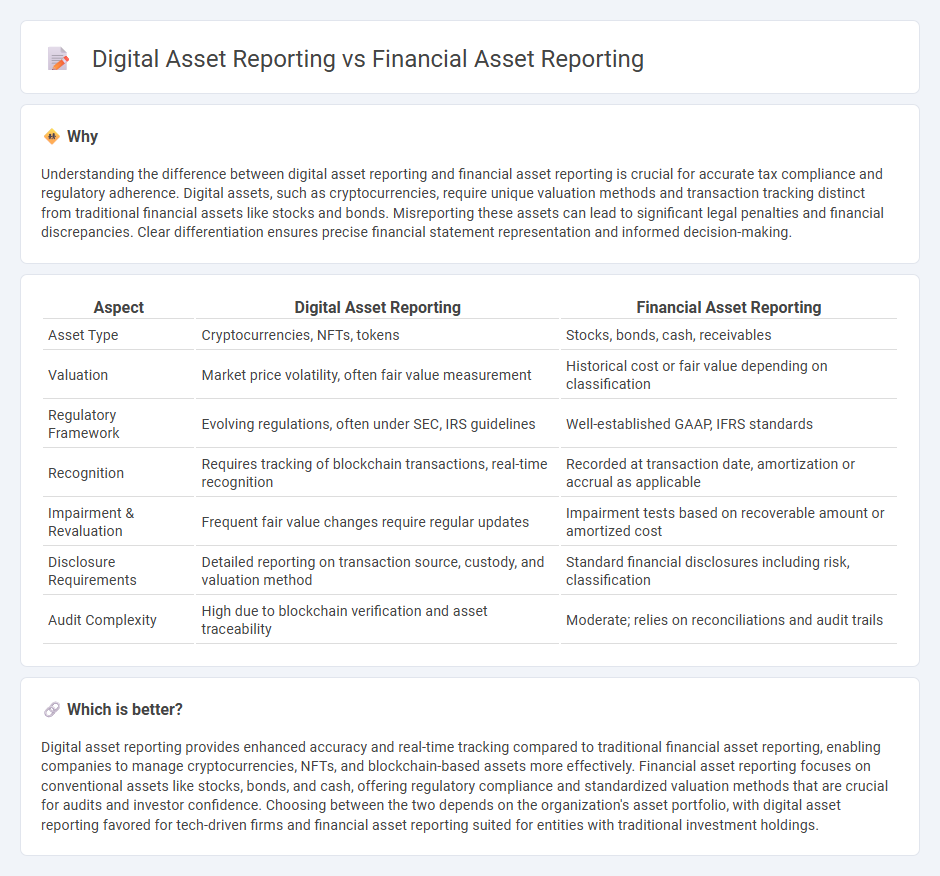
Digital asset reporting involves tracking and valuing cryptocurrencies, NFTs, and other blockchain-based assets using specialized accounting frameworks, which differ from traditional financial asset reporting that focuses on stocks, bonds, and cash equivalents. The unique characteristics of digital assets, including volatility, regulatory ambiguity, and decentralized ownership, require tailored approaches to ensure accurate valuation and compliance. Explore the nuances of digital versus financial asset reporting for a deeper understanding of modern accounting challenges.
Why it is important
Understanding the difference between digital asset reporting and financial asset reporting is crucial for accurate tax compliance and regulatory adherence. Digital assets, such as cryptocurrencies, require unique valuation methods and transaction tracking distinct from traditional financial assets like stocks and bonds. Misreporting these assets can lead to significant legal penalties and financial discrepancies. Clear differentiation ensures precise financial statement representation and informed decision-making.
Comparison Table
| Aspect | Digital Asset Reporting | Financial Asset Reporting |
|---|---|---|
| Asset Type | Cryptocurrencies, NFTs, tokens | Stocks, bonds, cash, receivables |
| Valuation | Market price volatility, often fair value measurement | Historical cost or fair value depending on classification |
| Regulatory Framework | Evolving regulations, often under SEC, IRS guidelines | Well-established GAAP, IFRS standards |
| Recognition | Requires tracking of blockchain transactions, real-time recognition | Recorded at transaction date, amortization or accrual as applicable |
| Impairment & Revaluation | Frequent fair value changes require regular updates | Impairment tests based on recoverable amount or amortized cost |
| Disclosure Requirements | Detailed reporting on transaction source, custody, and valuation method | Standard financial disclosures including risk, classification |
| Audit Complexity | High due to blockchain verification and asset traceability | Moderate; relies on reconciliations and audit trails |
Which is better?
Digital asset reporting provides enhanced accuracy and real-time tracking compared to traditional financial asset reporting, enabling companies to manage cryptocurrencies, NFTs, and blockchain-based assets more effectively. Financial asset reporting focuses on conventional assets like stocks, bonds, and cash, offering regulatory compliance and standardized valuation methods that are crucial for audits and investor confidence. Choosing between the two depends on the organization's asset portfolio, with digital asset reporting favored for tech-driven firms and financial asset reporting suited for entities with traditional investment holdings.
Connection
Digital asset reporting and financial asset reporting are interconnected through the systematic tracking, valuation, and disclosure of asset-related information within accounting frameworks. Both processes rely on accurate ledger entries and real-time data integration to ensure compliance with regulatory standards and enhance transparency in financial statements. The convergence of these reporting methods enables comprehensive asset management, fostering better decision-making and risk assessment in corporate finance.
Key Terms
**Financial Asset Reporting:**
Financial asset reporting involves the systematic documentation and analysis of investments such as stocks, bonds, and other securities, ensuring compliance with regulatory standards and providing transparency for stakeholders. It emphasizes accuracy in valuation, transaction details, and risk assessment to support informed decision-making and financial planning. Explore more to understand key practices and technological tools transforming financial asset reporting today.
Fair Value
Financial asset reporting emphasizes the accurate measurement and disclosure of fair value to reflect market conditions and ensure transparency for investors. Digital asset reporting integrates blockchain and real-time valuation technologies to provide enhanced accuracy and auditability of fair value assessments. Explore further to understand the evolving methodologies and regulatory implications in fair value reporting for both asset types.
Amortized Cost
Financial asset reporting under amortized cost focuses on valuing assets by adjusting the initial cost for principal repayments and amortization of premiums or discounts, reflecting the asset's effective interest rate over time. Digital asset reporting, while increasingly incorporating amortized cost methods for certain tokenized assets or stablecoins, often requires additional considerations for volatility and market-driven value changes. Explore the evolving standards and practices in amortized cost reporting for both financial and digital assets to understand their impact on accurate financial statements.
Source and External Links
Foreign Financial Assets: New Reporting Requirements - U.S. taxpayers must disclose specified foreign financial assets exceeding $50,000 at any time during the tax year on their income tax return, detailing the asset type, value, and location under Section 6038D of the Tax Code.
Do I Need to File Form 8938, Statement of Specified Foreign Financial Assets? - Form 8938 must be filed by U.S. taxpayers who have specified foreign financial assets exceeding $50,000, with the form attached to the annual income tax return.
Foreign Financial Assets Reporting: A Complete Guide to IRS Form 8938 - Reporting requirements for foreign financial assets depend on filing status and residency, with thresholds of $50,000 at year-end or $75,000 at any time (for single filers) or higher for married couples and those living abroad, and the assets must be detailed on IRS Form 8938.
 dowidth.com
dowidth.com